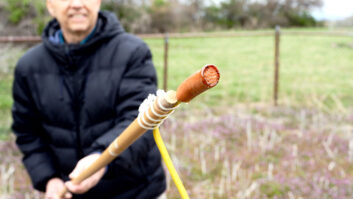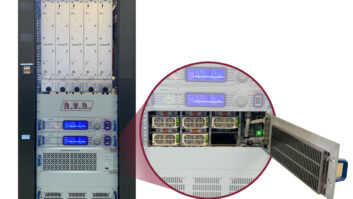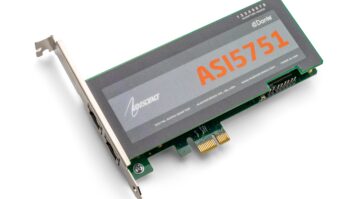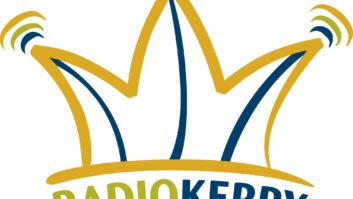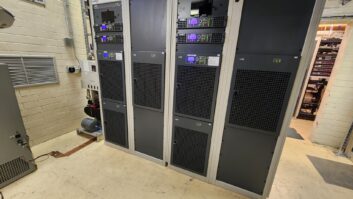When contract engineer Stephen Schuh replaced two old AM sites by diplexing the stations, he was required to use strobe lights, both night and day, due to bird flyway considerations. The new site is a quarter-mile from the Mississippi River.
Stephen used an Austin ring transformer to get the AC onto the tower to run the three strobe control systems; but he was left to develop a solution to get the alarm monitor signal off of the energized AM tower.

Fig. 1: A simple fiber optic encoder/decoder gets an alarm across an AM tower base insulator. He found an inexpensive and easy method thanks to Digikey and a company called Industrial Fiber Optics, Inc., which makes fiber optic LED encoders and fiber optic photo logic detectors as shown in Fig. 1. The pair is designed to mate with standard 1000 um core jacketed plastic fiber optic cable.
These small plastic devices have a “connector-less” design that allows you to cut the fiber and insert it into a captive plastic housing that locks the fiber by means of a cinch nut. Gone is the tedious and expensive splicing of fiber optic cable.
In this case, Steve just needed the equipment to provide a simple on/off indication to alarm the remote control; but these devices also can be used for reasonably priced digital data links. You might find them useful if you need to transfer a signal and need EMC/EMI signal isolation.
The cost of the LED, detector and 30 feet of fiber was $30. As seen in Fig. 2, there are few extra parts required other than power supplies to assemble the devices.
Stephen used the normally closed (NC) alarm contacts on the Flash Technology controllers to keep the LED on and provide a failsafe supervised system.

Fig. 2: The encoder/detector is installed using ‘connector-less’ fiber optic cable. Custom-length cabling becomes a breeze. Check out the encoder/detector at www.i-fiberoptics.com. To order the parts, Digikey’s site is www.digikey.com.
Thanks, Steve, for an inexpensive solution to a troubling issue for AM engineers with strobe systems on hot towers.
Steve’s been operating Schuh Electronics for about 30 years. He is a Minnesota licensed technology contractor, working mostly in the North Star state but also in Iowa and Wisconsin. His site is www.schuhelectronics.com. When you go to his site, click on “My Shop.” It is housed at the old KWNO transmitter building in Winona. The building and tower date to 1948.
* * *
You can find great engineering consultants in the Broadcast Equipment Exchange classified section of Radio World. Just look under “Consultants.”
I’ve often recommended professional consulting engineer Web sites as a source for reference information. After reading the June 3 Workbench, in which we described the use of a Potomac FIM21/41 for finding ground radials, engineer Jim Liffrig, transmitter supervisor for KRVN(AM) in Nebraska, shares a site you should bookmark.
Go to Hatfield & Dawson at www.hatdaw.com, click on “Downloads” and scroll almost to the bottom of the page to “Use of FIM 21/41 for location of ground radials.”

Fig. 3: The marriage of data with Google Earth offers a unique interpretation of the 7 GHz links at San Francisco’s Sutro tower, courtesy of Cavell, Mertz & Associates. One suggestion includes a picture that shows a handle with a 1/4-20 bolt in the end. The handle screws into the bottom of the meter so you can hold the device upside down, close to the ground, as you sense radials. If you’ve checked radials by just holding the meter, you can appreciate that this is an excellent addition that can save your back.
Jim used the screw-on handle from an old RF knife switch that had been decommissioned long ago and was sitting in his junk box. Problem solved. The drawings also show a method to desensitize the meter for high RF fields.
* * *
Similarly, if you haven’t visited FCCInfo.com, created by Cavell Mertz & Associates, you’re in for a treat. This database has been around for eight years and shows up-to-date FCC broadcast, microwave and tower structure information.
The databases now have been combined with mapping capabilities of Google Earth. A 3D display of both building and terrain offers a unique perspective of viewing FCC data. Fig. 3 shows the 7 GHz fixed microwave sites at the Sutro Tower in central San Francisco. Fig. 4 shows a composite of radio and television facilities in Washington and, to the lower left, facilities in Arlington, Va.
Since 1989, the firm has been providing consulting, mapping and data services to the telecommunications industry. Its main site is www.cavellmertz.com.
* * *

Fig. 4: From FCCInfo, here’s a composite showing radio and television sites in the nation’s capital. Based on the above items, it’s obvious that we have a lot of resources at our disposal.
Most engineers have used basic electronic programs for finding transmission line loss or calculating resistor pads at some point in their careers. What you probably don’t know is that a good number of these programs were developed by the late Steve Schott.
Steve started developing the programs when he worked for Collins Radio and he improved on them during his stints at Harris, BE and, most recently, Continental. Steve never sought notoriety or compensation; it was simply his way of giving back to an industry that had been so good to him.
He was known for his friendly smile and he was always helpful, not only to his customers but also his co-workers. He was one of the most unpretentious guys I’ve ever known. There are lots of great stories about Steve, who flew gliders, sailed, enjoyed scuba diving and was president of the Texas Old English Sheepdog Rescue Organization.
At a national sales meeting a few companies back, Steve and I were sitting with a couple of middle managers who were bragging about their expensive Cartier and Montblanc pens.
“I bought mine at Tiffany and it cost $300,” one said.
“I picked mine out at the Montblanc store in Chicago for nearly $500,” replied the other.
Steve pulled a ballpoint pen out of his shirt pocket, clicked it and said with a chuckle, “I got mine free, from Tony’s Tire and Auto.”
This down-to-earth guy died on May 28. His formula CDs continue to help engineers. What a neat legacy.
John Bisset has worked as a chief engineer and contract engineer for 39 years. He is international sales manager for Europe and Southern Africa for Nautel. In 2007 he received the SBE’s Educator of the Year Award. Reach him at[email protected]. Faxed submissions can be sent to (603) 472-4944.
Submissions for this column are encouraged and qualify for SBE recertification credit.





